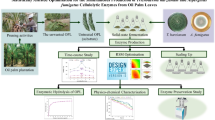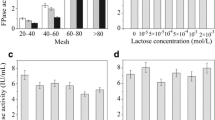Abstract
Due to the limited natural resources, the tendency toward using agro-industrial wastes as the main substrate in the biotechnological productions has increased. In order to obtain biologically available compounds out of these wastes, various extraction processes need to be applied. However, during these processes, some other inhibitory compounds such as furfural and hydroxymethylfurfural (HMF) also occur. Therefore, evaluation of these inhibitor effects on the biological systems before using these wastes as substrate is crucial for the overall success of the process. This study was undertaken to investigate the effect of various concentrations of furfural and HMF on the Aspergillus niger A42 (ATCC 204,447) inulinase activity, invertase activity, biomass production, and sugar consumption in sucrose-based medium and to model the production outcomes. The results showed that furfural had higher inhibitory effect on the process than HMF at the same concentrations. However, fungi were able to tolerate up to 3 g/l of HMF or 0.5 g/l of furfural in the production medium with minor changes in the yield. The highest inulinase activities were measured as 268.737 and 197.350 U/ml in the presence of 1 g/l of HMF and 0.1 g/l of furfural, respectively. In these conditions, inulinase productions were successfully represented by Baranyi and Weibull models. This study clearly showed that inulinase production with Aspergillus niger A42 can be successfully performed in the presence of a certain amount of furfural and HMF, which indicates the strength of potential usage of lignocellulosic materials as production substrate.







Similar content being viewed by others
Data availability
Data available on request from the authors.
Abbreviations
- a:
-
Delay phase transition coefficient A0
- A0 :
-
Lower asymptote (g/l or U/ml)
- AF:
-
Accuracy factor (–)
- Am :
-
Upper asymptote (g/l or U/ml)
- ATCC:
-
American Type Culture Collection
- BF:
-
Bias factor (–)
- Bt :
-
Transition function
- d:
-
Unitless design parameter
- e:
-
Euler number, 2.718 (–)
- Eq:
-
Equation
- h0 :
-
A parameter calculating the initial physiology state of the cells (g/l or U/ml)
- HMF:
-
5-Hydroxymethyl furfural
- H t :
-
Transition function
- k:
-
A parameter governing the rate at which the response variable approaches its potential maximum (–)
- MAE:
-
Mean absolute error
- MGM:
-
Modified Gompertz model
- MLM:
-
Modified logistic model
- MMF:
-
Morgan–Mercer–Flodin
- MRM:
-
Modified Richards model
- n:
-
Number of observations (–)
- Q:
-
Maximum production-consumption rate (g/l/day or U/ml/day)
- QIase :
-
Maximum inulinase production rate (U/ml/day)
- QS :
-
Maximum sugar utilization rate (g/l/day)
- QSase :
-
Maximum invertase-type production rate (U/ml/day)
- R2 :
-
Determination coefficient (–)
- RMSE:
-
Root mean square error
- SUY:
-
Sugar utilization yield (%)
- t:
-
Sampling time (days)
- TL :
-
Time at half of Am (days)
- v:
-
Dimensionless shape parameter (–)
- X:
-
Total dry biomass (g/l)
- β:
-
Growth displacement (–)
- δ:
-
Allometric constant
- ΔS:
-
Substrate consumption (g/l)
- λ:
-
Lag time (days
References
Singh R, Singh R (2017) Inulinases. In: Current developments in biotechnology and bioengineering. Elsevier, pp 423–446
Driouch H, Hänsch R, Wucherpfennig T, Krull R, Wittmann C (2012) Improved enzyme production by bio-pellets of Aspergillus niger: targeted morphology engineering using titanate microparticles. Biotechnol Bioeng 109(2):462–471
Silva-Santisteban BOY, Maugeri Filho F (2005) Agitation, aeration and shear stress as key factors in inulinase production by Kluyveromyces marxianus. Enzyme Microb Technol 36(5–6):717–724
Ilgın M, Germec M, Turhan I (2019) Inulinase production and mathematical modeling from carob extract by using Aspergillus niger. Biotechnology Progress
Germec M, Gürler HN, Ozcan A, Erkan SB, Karahalil E, Turhan I (2020) Medium optimization and kinetic modeling for the production of Aspergillus niger inulinase. Bioprocess and Biosyst Eng 43(2):217–232
Germec M, Turhan I (2019) Evaluation of carbon sources for the production of inulinase by Aspergillus niger A42 and its characterization. Bioprocess Biosyst Eng 42(12):1993–2005
Karahalil E, Germec M, Karaoglan M, Yatmaz E, Coban HB, Inan M, Turhan I (2020) Partial purification and characterization of a recombinant β-mannanase from Aspergillus fumigatus expressed in Aspergillus sojae grown on carob extract. Biomass Convers Biorefinery 10(4):1189–1205
Germec M, Turhan I (2021) Effect of pH control and aeration on inulinase production from sugarbeet molasses in a bench-scale bioreactor. Biomass Convers Biorefinery:1–13
Gürler HN, Germec M, Turhan I (2020) The inhibition effect of phenol on the production of Aspergillus niger inulinase and its modeling. J Food Process Preserv 45(8):e14522
Galbe M, Wallberg O (2019) Pretreatment for biorefineries: a review of common methods for efficient utilisation of lignocellulosic materials. Biotechnology for Biofuels 12(1):1–26
Almeida JR, Modig T, Petersson A, Hähn-Hägerdal B, Lidén G, Gorwa-Grauslund MF (2007) Increased tolerance and conversion of inhibitors in lignocellulosic hydrolysates by Saccharomyces cerevisiae. J Chem Technol Biotechnol: Int Res Process, Environ Clean Technol 82(4):340–349
Erkan SB, Yatmaz E, Germec M, Turhan I (2020) Effect of furfural concentration on ethanol production using Saccharomyces cerevisiae in an immobilized cells stirred‐tank bioreactor with glucose‐based medium and mathematical modeling. J Food Process Preserv 45(8):e14635
Malav MK, Prasad S, Kharia SK, Kumar S, Sheetal K, Kannojiya S (2017) Furfural and 5-HMF: potent fermentation inhibitors and their removal techniques. Int J Curr Microbiol Appl Sci 6:2060–2066
Lin R, Cheng J, Ding L, Song W, Zhou J, Cen K (2015) Inhibitory effects of furan derivatives and phenolic compounds on dark hydrogen fermentation. Biores Technol 196:250–255
Anburajan P, Pugazhendhi A, Park J-H, Kumar G, Choi C-S, Kim S-H (2017) Inhibitory effect of 5-hydroxymethylfurfural on continuous hydrogen fermentation by mixed culture in a fixed bed reactor. Int J Hydrogen Energy 42(45):27570–27576
Zwietering M, Jongenburger I, Rombouts F, Van’t Riet K (1990) Modeling of the bacterial growth curve. Appl Environ Microbiol 56(6):1875–1881
Stannard C, Williams A, Gibbs P (1985) Temperature/growth relationships for psychrotrophic food-spoilage bacteria. Food Microbiol 2(2):115–122
Weibull W (1951) Wide applicability. J appl mech 103(730):293–297
Morgan PH, Mercer LP, Flodin NW (1975) General model for nutritional responses of higher organisms. Proc Natl Acad Sci 72(11):4327–4331
Dantigny P, Nanguy SP-M, Judet-Correia D, Bensoussan M (2011) A new model for germination of fungi. Int J Food Microbiol 146(2):176–181
Baranyi J, Roberts TA (1994) A dynamic approach to predicting bacterial growth in food. Int J Food Microbiol 23(3–4):277–294
Huang L (2013) Optimization of a new mathematical model for bacterial growth. Food Control 32(1):283–288
Fitzhugh H Jr (1976) Analysis of growth curves and strategies for altering their shape. J Anim Sci 42(4):1036–1051
Miller GL (1959) Use of dinitrosalicylic acid reagent for determination of reducing sugar. Anal Chem 31(3):426–428. https://doi.org/10.1021/ac60147a030
Zhang H, Zhang J, Bao J (2016) High titer gluconic acid fermentation by Aspergillus niger from dry dilute acid pretreated corn stover without detoxification. Biores Technol 203:211–219
Acknowledgements
The first author was supported by TUBITAK (The Scientific and Research Council of Turkey) National Scholarship Program for MSc Students. This work was supported by the Akdeniz University Research Foundation (Grant number #FYL-2019-4755).
Author information
Authors and Affiliations
Contributions
All authors contributed to the study conception and design. Material preparation, data collection, and analysis were performed by HNG, HBC, and IT. The first draft of the manuscript was written by HNG, and all authors commented on previous versions of the manuscript. All authors read and approved the final manuscript.
Corresponding author
Ethics declarations
Conflict of interest
The authors declare no competing interests.
The authors declare that they have no known competing financial interests or personal relationships that could have appeared to influence the work reported in this paper.
The authors declare the following financial interests/personal relationships which may be considered as potential competing interests:
Additional information
Publisher's note
Springer Nature remains neutral with regard to jurisdictional claims in published maps and institutional affiliations.
Rights and permissions
About this article
Cite this article
Gürler, H.N., Coban, H.B. & Turhan, I. Investigation of the inhibitory effects of furfural and hydroxymethylfurfural on the production of Aspergillus niger inulinase and modeling of the process. Biomass Conv. Bioref. 13, 4291–4303 (2023). https://doi.org/10.1007/s13399-022-02440-1
Received:
Revised:
Accepted:
Published:
Issue Date:
DOI: https://doi.org/10.1007/s13399-022-02440-1




